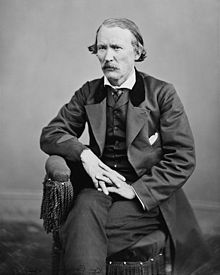
Back كيت كارسون Arabic Кит Карсън (пътешественик) Bulgarian Kit Carson Catalan Kit Carson Czech Kit Carson Welsh Kit Carson Danish Kit Carson German Κιτ Κάρσον Greek Kit Carson Esperanto Kit Carson Spanish
This article has multiple issues. Please help improve it or discuss these issues on the talk page. (Learn how and when to remove these messages)
|
Kit Carson | |
|---|---|
 Carson on a visit to Washington, D.C., 1868 | |
| Born | Christopher Houston Carson December 24, 1809 Richmond, Kentucky, U.S. |
| Died | May 23, 1868 (aged 58) Fort Lyon, Colorado Territory, U.S. |
| Resting place | Kit Carson Cemetery, Taos, New Mexico |
| Occupation(s) | Mountain man, frontiersman, guide, Indigenous agent, United States Army officer |
| Known for |
|
| Spouses |
|
| Military career | |
| Allegiance | Union |
| Service | Union Army |
| Rank | Brevet Brigadier General |
| Commands | 1st New Mexico Volunteer Cavalry Regiment |
| Battles / wars | Mexican–American War |
| Signature | |
Christopher Houston Carson (December 24, 1809 – May 23, 1868) was an American frontiersman. He was a fur trapper, wilderness guide, Indian agent and U.S. Army officer. He became a frontier legend in his own lifetime through biographies and news articles; exaggerated versions of his exploits were the subject of dime novels. His understated nature belied confirmed reports of his fearlessness, combat skills, tenacity, as well as profound effect on the westward expansion of the United States. Although he was famous for much of his life, historians in later years have written that Kit Carson did not like, want, or even fully understand the fame that he experienced during his life.[1]
Carson left home in rural Missouri at 16 to become a mountain man and trapper in the West. In the 1830s, he accompanied Ewing Young on an expedition to Mexican California and joined fur-trapping expeditions into the Rocky Mountains. He lived among and married into the Arapaho and Cheyenne tribes.
In the 1840s, Carson was hired as a guide by John C. Frémont, whose expeditions covered much of California, Oregon, and the Great Basin area. Frémont mapped and wrote reports and commentaries on the Oregon Trail to assist and encourage westward-bound pioneers, and Carson achieved national fame through those accounts. Under Frémont's command, Carson participated in the conquest of California from Mexico at the beginning of the Mexican–American War. During this time, he also participated in the Frémont-led Sacramento River massacre and Klamath Lake massacre against Indigenous peoples. Later in the war, Carson was a scout and courier who was celebrated for his rescue mission after the Battle of San Pasqual and for his coast-to-coast journey from California to Washington, D.C., to deliver news of the conflict in California to the government. In the 1850s, he was appointed as the Indian agent to the Ute Indians and the Jicarilla Apaches.
During the American Civil War, Carson led a regiment of mostly Hispanic volunteers from New Mexico on the side of the Union at the Battle of Valverde in 1862. When the Confederate threat was eliminated in New Mexico, Carson led forces to suppress the Navajo, Mescalero Apache, Kiowa, and Comanche tribes by destroying their food sources. He was breveted a brigadier general and took command of Fort Garland, Colorado. He was there only briefly, as poor health forced him to retire from military life.
Carson was married three times and had ten children. He died at Fort Lyon of an aortic aneurysm on May 23, 1868. He is buried in Taos, New Mexico, next to his third wife, Josefa.
During the late nineteenth century, Kit Carson became a legendary symbol of America's frontier experience, which influenced twentieth century erection of statues and monuments, public events and celebrations, imagery by Hollywood, and the naming of geographical places. In recent years, Kit Carson has also become a symbol of the United States' mistreatment of its indigenous peoples.[2][citation needed]
- ^ Momaday, N. Scott (October 29, 2006). "Cowboys and Indians". The New York Times.
- ^ "Kit Carson". Equestrian Statues. April 6, 2016.